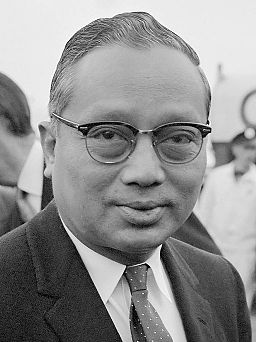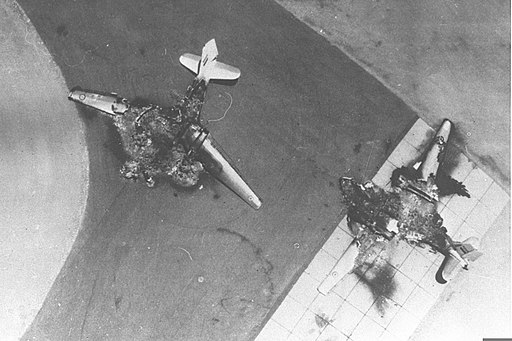A superpower trying to mix things up. Agreements are violated. An incredible fight against all odds. And an amazing victory.
Welcome to the Six Day War of 1967.
- Introduction to the Six Day War
- Things Escalate
- The Six Day War Begins
- Aftermath and Summary of The Six Day War
Introduction to the Six Day War
It is 1967. NASA launches the Lunar Orbiter 3 spacecraft, The Beatles release their acclaimed album “Sgt. Pepper’s Lonely Hearts Club Band”, and Elvis Presley marries Priscilla.
And as always, there’s trouble in the Middle East.
Before we continue, here’s what you need to know about the President of Egypt, Nasser (you can find the full details in The Suez Crisis of 1956 post).
Gamal Abdel Nasser is the second President of Egypt and is pretty much the reason for three of the Israeli-Arab wars.

Nasser is an Egyptian and Arab nationalist, who believes in Arab glory. In 1948 he took part in Israel’s War of Independence and was besieged by Israeli forces for 4 months, but did not break. So when he finally returned to Egypt, he was received as a hero.
Nasser became a respected military officer, climbing through the ranks, and then turned to politics. He led the 1952 overthrow of the monarchy and introduced far-reaching land reforms the following year.
After an attempt on his life by a Muslim Brotherhood member, he cracked down on the organization, put President Mohamed Naguib under house arrest and assumed executive office in 1954. He was formally elected president in June 1956.
That’s all you need to know, so let’s continue the story…
Throughout 1966, Syria launched many attacks against Israel, either directly or by allowing the Palestine Liberation Organization (PLO) to operate from its territory. The Syrian leaders did so since they believed that the best way to defeat Israel is by using guerilla warfare, just like the Vietnamese used against the US.
The direct (and proxy) attacks included bombs, mines under main roads, snipers shooting at farmers and many more creative attacks. Generally, the hostiles were trying and succeeding in killing Israeli citizens from a safe distance.
As the attacks kept occurring, Israel tried to deter Syria by attacking Syrian military assets – it is Syria who allowed the PLO to operate from its territory, hence it was held responsible for the hostilities. And as Israel attacked, tensions grew higher and higher, and intimidating verbal threats were made on both sides.
The Syrian leaders started to worry – what would happen if they eventually crossed the line? Poked the bear? Messed with the bull? Or plainly, did something that would cause Israel to start a war? They needed an ally – they clearly could not face Israel alone.
Hence, Syria and Egypt signed a mutual defense treaty providing for joint command in November of 1966. Despite this agreement, there were still many tensions and frictions between the Arab states bordering Israel- Egypt, Syria and Jordan.
A superpower tries to mix things up
As you may remember, the cold war is going on, and both the US and USSR try to gain influence around the world.
The USSR comes up with an interesting idea – “What if we could unite the Arab states, while gaining influence and selling weapons? Do you know what unites people most? A common enemy”.
So the USSR decides to mix things up. It makes up and distributes fake intelligence. Some may even call it “fake news”.
A western intelligence organization managed to intercept a telegram sent from the Soviet embassy in Cairo, Egypt to the Ministry of Foreign Affairs in Moscow.
And it read:
“Today, we delivered to the Egyptian authorities the information about the Israeli massing of troops with the intent to carry out an act of aggression against Syria, and we advised the government of the United Arab Republic (this means Egypt) to take proper actions“.
This information is also sent to Syrian and Lebanese authorities.
When the Egyptian President, Nasser, tries to confirm the information and verify it with other Arab security agencies, he is convinced that the information is true – both Syria and Lebanon confirm the intel. Little does he know that the security agencies of Syria and Lebanon received the same fake intelligence from the very same source…
And so the cookie starts to crumble – the USSR plants fake seeds, and a very real explosive plant is about to grow.
Things Escalate
Nasser is convinced that an Israeli attack on Syria is imminent. And he has to honor the mutual defense treaty between his country and Syria.
He does not want to go to war, as he believes it is not yet the time. He wants to deter Israel from attacking Syria, showcase the Egyptian strength and create a credible threat without actually going to war.

So, on May 14th 1967 Nasser decides to move massive amounts of armor, infantry and fighter planes into the Sinai Peninsula, threatening Israel’s Southern border and deterring Israel from attacking in the North. Israel wouldn’t want to start a war on two fronts, would it?
On May 15th, the Egyptian forces execute Nasser’s orders and just pour into the desert. Literally tens of thousands of troops, thousands of tanks and other heavy armor, dozens of fighter jets wash through the desert and make their way towards Israel.
Though Nasser really wants to deploy tanks right on the border with Israel, he can’t. There is just one problem – named UNEF.
Wait, what? What is UNEF?
Well, after The Suez Crisis, Israel wanted guarantees for two things. The first – free passage through the Straits of Tiran for Israeli shipping. The second – means to make sure that Egypt will not be able to launch surprise attacks on Israel from the South. This is due to the fact that Israel is a very small country, and has no strategic depth. If the Egyptians manage to launch an attack, they can reach most of the major cities within the first 80 km (50 miles).
The mechanism to secure both things is the UNEF – UN Emergency Force. Since 1956, UN soldiers are stationed in Sinai, making sure that the Egyptians don’t sneak up to the border, and making sure the Egyptians keep the Straits of Tiran open for Israeli shipping.
So how can Nasser deploy tanks on the border, when 3,400 UNEF soldiers are there to prevent it?
His plan is to order the UN forces to leave their posts on the border and group in UN bases, away from the border. He has done it before when he wanted to flex a little (in 1960). However, the UN Secretary-General has since been replaced. And the new Secretary-General is not so… understanding.
Meet U Thant. UN Secretary-General, full of good intentions and critical misinterpretations.
In accordance to Nasser’s orders, the Egyptian Chief of Staff sends a message to the UN commander in Sinai:
“I hereby inform you that I have ordered all of the Egyptians armed forces to prepare for action against Israel, if and when an act of aggression against any Arab state should occur. In line with these orders, our forces have massed on our Eastern border of Sinai (the border with Israel). To ensure the safety of the UNEF soldiers, I demand that you order the evacuation of said soldiers from their posts, and gather them in the UN bases located in Gaza”.
Pay close attention to the message, as the Egyptian Chief of Staff chooses his words carefully. He does not demand the extraction of the UNEF permanently, only gathering them away from the border temporarily. And he does not mention the UNEF soldiers keeping the Straits of Tiran open.
The message tries to kill two birds with one stone. The first – prove to the Egyptians and to the Arab world that Nasser is not afraid to confront the UN and drive it out of the border in order to confront Israel. The second – signal that Egypt does not plan to provoke Israel too much (and this is due to the fact that the Straits of Tiran are not mentioned).

When U Thant gets the message from the UN commander, he gathers a meeting. He hears that the Egyptians expressed their desire in the UNEF presence on the border just three months ago. He is told that the message is illegal, and that it looks like Egypt is trying to test the UN. And he is advised to play hardball – either the UNEF forces are stationed in Sinai and do their job properly, or the UN pulls the UNEF from Sinai. Since the Egyptians supposedly want the UNEF presence, Nasser will have to back off, won’t he?
U Thant agrees with this plan. It makes sense, after all. So he calls the Egyptian ambassador to the UN, and tells him that Egypt has to choose – either keeping the freedom of the UNEF to do its job, or the evacuation of the UNEF from Sinai.
Can you guess what happens next?
Remember that we said that Nasser believes in Arab glory, status and radiating power? So when a person like that needs to choose between backing off and looking weak or not backing off and thus gaining the respect of the Arab world, which option do you think that person would choose?
That’s right. Nasser chooses that the UN evacuate its forces from Sinai, and on May 19th the UNEF leaves Sinai.
All this time, Israel is left alone in the international arena. Israeli diplomats work vigorously to get some sort of public support, any statement that would reaffirm commitments of the international community to the agreements achieved after the Sinai war.
However, Not only do the US, the UK and France not express support for Israel, they also ask Israel to refrain from action, and state that they would not support Israel if it does any move unilaterally.
Or, to put in other words – the powers that should enforce the guarantees that were made in 1957 just tell Israel to give up the guarantees.
Nasser notices this deafening silence. He sees that he is not reprimanded for his actions. He pulls and pulls the rope and nothing bad happens – the international community does not threaten him, and neither does Israel. And to put the cherry on top, he is again considered a hero in the eyes of the Arab world.
So he decides to level up. Drunk with his success, he decides to go all in – and he closes the Straits of Tiran to Israeli shipping on the night of 22–23 May.
As early as 1957, Israel repeatedly declared that any closure of the Straits would be considered an act of war, or justification for war. But Nasser is on a roll, so why should he stop now?

Things look worse and worse for Israel. Again, the international community just stands by as Nasser increases his acts of aggression.
And that’s not all!
Since Israel did not start a war, it is now perceived as weak in the rough neighborhood we call The Middle East. So Jordan agrees to let foreign Arab military forces enter its territory in preparation for potential conflict. Israel previously said that this would be considered an act of war, but look at the Straits of Tiran. On 30 May, Jordan and Egypt sign a defense pact.
So let’s look at things through the Israeli point of view. The point of view that is unaware of the fake USSR intelligence that started it all:
– Egypt in the South and Syria in the North have a defense pact.
– Syria keeps attacking Israel, directly or via proxies.
– Egypt drives the UNEF forces out of Sinai. It then proceeds to close the Straits of Tiran to Israeli shipping, effectively nullifying all of the agreements achieved after the Sinai war.
– Jordan in the East signs a defense pact with Egypt, and allows foreign Arab military forces to enter its territory in preparation for potential conflict with Israel.
– The international community does not publicly back Israel up or reprimand Egypt for its aggression.
I don’t know about you, but I can feel the noose tightening around Israel’s neck. Enemies are preparing to close in from all sides, and no superpower supports Israel nor deters Egypt.
To make things even worse, no western country or superpower takes any physical action to restrain Egypt. On the contrary, Western leaders warn Israel not to take any action, not to start a war. They urge Israel to wait and effectively to give up the right of passage through the Straits of Tiran.
But that’s not enough. While Egypt continues to buy and deploy weapons from the USSR, Israel is not so lucky. France, the main supplier of weapons to Israel, decides to halt all shipments to the Middle East, thinking this would prevent war. Since the only client France has in the Middle East is Israel, the decision feels kind of… personal.
The future looks bleak. Every minute of diplomacy, every minute of restrain, just makes things worse and worse for Israel.
So as an Israeli seeing all this happen, tell me – what would you do?
On the night of 3–4 June, after about 3 weeks of immense and futile diplomatic efforts, Israel decides to go to war.
The concerns are massive.
In 1956, the UK, France and Israel attacked Egypt together. And now? Israel has never been lonelier. It has to face Egypt, Jordan and Syria. It has to face reinforcements that have already been sent from Iraq. It has to face the whole Arab world, that unites around Nasser. It has to face the diplomatic backlash and perhaps embargo that will follow. Can Israel do it all alone?
The Six Day War Begins
How do you open a war when you don’t have the element of surprise?
You create one yourself.
On the morning of June 5th, Israel launches its most elaborate, successful, mind blowing operation ever – Operation Focus, the opening strike of the Six Day War.
In this operation, the Israeli Air Force (IAF) proved to be one of the most creative and competent air forces in the world.
As the command “Focus – go!” is issued, almost two hundred Israeli fighter planes take off, in intervals calculated down to the second. Maintaining complete radio silence, they fly to the North, then West over the Mediterranean Sea, and then turn South. They fly almost at sea level, to remain undetected by Egyptian radars.
The zero hour arrives – 8:45 Cairo time. In this exact moment, all of the might of the Israeli Air Force is unleashed at once. It is unleashed over 11 of the 14 Egyptian air bases, shaking the earth, destroying the runways as well as the planes parking on the ground before they have a chance to get airborne.
The Israeli planes then return to Israel, refuel and rearm in 7 minutes 30 seconds, and leave for a second wave that attacks all of the 14 Egyptian bases. They refuel and rearm again, and depart in a third wave.

Jordan, Syria and Iraq join the war, and send fighter jets of their own to attack Israel. Since the Egyptian air force is pretty much extinct, the third wave destroys the airfields and airplanes of Jordan and Syria, as well as the Western airfield of Iraq.
Overall, the success is amazing – in the first day of the war, Israel destroys 451 airplanes and helicopters (about 70 percent of the Arab air force). Most of the airfields in Egypt, Syria and Jordan can no longer be used. The Israeli Air Force gains aerial supremacy, meaning that it is free to aid the ground forces for the rest of the war. And it does all this while only losing 19 airplanes (about 10 percent of its force).
On the first day of the war, June 5th, the main effort is in Sinai, where 100,000 Egyptian troops pose an existential threat to Israel.
After destroying almost all of the Egyptian air force, Israel starts an all-in armored ground assault, trying to break through the Egyptian lines and occupy strategic points in Sinai.
The other fronts (with Jordan and Syria) are in defensive mode, prepared to block attacks but not initiate any moves. All the while, Jordan and Syria bombard Israeli cities with artillery and mortars.
In rapid attacks, non stop fighting and superior skills, the Israeli tanks and troops wash through Sinai. Though greatly outnumbered in each and every fight, the Israeli forces manage to win battle after battle, destroy Egyptian platoons and capture strategic positions deeper and deeper in Sinai.
This success allows Israel to shift the focus to other fronts. Due to the non-stopping bombardment of Eastern Jerusalem by Jordan, a decision is made – Israel is about to take initiative in the Eastern front.
“The Temple Mount is ours”
At this point in time, Jerusalem is divided between Israel and Jordan. The Western part of Jerusalem belongs to Israel, and the Eastern part belongs to Jordan.
The part that belongs to Jordan includes many places of Jewish religious significance. Most importantly, it includes the old city of Jerusalem, in which lies the holiest place to Jews – Temple Mount. Sadly for the Jews, they are not allowed to visit the holy places under Jordanian regime.
The fights against the Jordanians are some of the toughest and bloodiest that Israel encountered during the Six Day War. The Jordanians are highly skilled and disciplined. The battlefield is urban, consisting of narrow streets and alleyways. The city of Jerusalem is mountainous, and Jordan has the higher ground.
But Israel has determination. It has faith. And it has no other choice but victory, since a defeat means the end of Israel.
So, with huge effort and immense sacrifice, Israeli troops start the fight. They manage to advance, inch by inch, street by street. Every small victory comes at a cost. Every inch is redeemed by blood.
And on June 7th, history is made. The Israeli paratroopers manage to capture the holiest place of all. “The Temple Mount is ours” is heard over the radio. For the first time in over 2000 years, the old city of Jerusalem, the city of David, is once again under Israeli control.
After occupying Jerusalem and the West Bank from Jordan, Jordan agrees to stop the fighting and a cease fire is achieved.

On the same day in Sinai, June 7th, Israel continues to go deeper and deeper. Israeli forces reach 20-70 kilometers (14-45 miles) from the Suez Canal. They also seize control of the Straits of Tiran. In the evening, Israel declares that the Straits of Tiran are once again open to each and every nation in the world – including Egypt… And on June 8th, Israel holds all of Sinai, up to the Suez Canal.
What about Syria? Syria has been launching attacks on Israeli villages for years now. How come I haven’t heard anything on that front?
You are right. But just as Captain Jack Sparrow said in Pirates of the Caribbean, you have to wait for the opportune moment.
On June 9th, that moment arrives. After his air force is destroyed, his armored corps defeated and Sinai occupied, Nasser decides to cease fire. This means that two out of the three fronts no longer require concentrated efforts.
The front with Syria is not an easy one. For starters, the Syrian army sits at the top of Golan Heights, several hundred meters (several thousand feet) above sea level. The Israeli army sits at about sea level, meaning that it would have to go up a very steep way, where Syria has the higher ground.
Another daunting fact is that over the years, Syria turned the Golan Heights and the border area to a huge fortified bunker, with snipers, machine guns, artillery and other nasty surprises.

But Israeli leadership knows that the clock is ticking. Soon, international pressure will force all sides to hold fire. There is no time to wait. The attack must start.
Using a combined operation of the air force, armored corps and infantry, Israel engages in an uphill battle. As the fighting continues, the morale of the Syrian army diminishes. And within two days, Israel seizes control of the Golan Heights and part of Mt. Hermon.
The Six Day War is over.
Less than ten days after the war, the Israeli government voted unanimously to return the Sinai Peninsula to Egypt and the Golan Heights to Syria in return for peace agreements. The government also resolved to open negotiations with King Hussein of Jordan regarding the Eastern border.
However, a reply was not received.
In September 1967, the Arab League held a summit in Khartoum, the capital of Sudan. The Arab states pass a resolution known as the three no’s: no peace with Israel, no recognition of Israel, no negotiations with it.
Aftermath and Summary of The Six Day War
Casualties:
Israeli casualties stand at about 780 dead, 4,517 wounded and 15 captured. 400 tanks and 46 aircrafts were destroyed.
Egypt casualties are 10,000-15,000 dead or missing, 4338 captured.
Jordanian casualties are 700-800 dead or missing, 533 captured.
Syrian casualties are 1,000-2,500 dead or missing, 591 captured.
The Arab states lost hundreds of tanks and over 450 aircrafts.
So who won The Six Day War? Who lost? What is the aftermath of the war?
Israel – huge military win!
Israel nearly triples in size in just six days! Israel seizes the Gaza Strip, the Sinai Peninsula, the West Bank of the Jordan River (including East Jerusalem), and the Golan Heights.
Israel gains strategic depth in the front with Egypt, since it now holds all of the Sinai Peninsula, and pushes Syria and Jordan away from Israeli cities and villages.

Israel’s military strength overwhelms the bordering Arab states, proving that Israel cannot be wiped out in war.
And last but not least, Israel gains control over the holy places of Jerusalem, allowing Jews to visit them for the first time since 1948.
It’s not all positive though…
Israel – long term loses
For starters, Israel’s public image shifts from being the underdog to being an aggressor, and that’s never good.
The bigger problem is that Israel now controls hundreds of thousands of Palestinians. This has long term implications inside Israel, dividing the Israeli society on how to handle this issue. This also hurts Israel’s public image around the world.
Egypt – huge military loss
Egypt lost pretty much all of its air force – while on the ground. It also lost the Sinai Peninsula, the control over the Straits of Tiran and the Gaza strip.
The huge gap between the militant propaganda before the Six Day War and the disgraceful defeat in the war caused shock in the Egyptian society. And most importantly, Israel is now perceived as a substantial threat to Egypt, since it has a vast military presence on the East shores of Suez Canal.
Jordan – lose
Jordan lost control over the West Bank and Jerusalem, as well as pretty much all of its air force.
Syria – lose
Syria lost control over the Golan Heights and Mt. Hermon, as well as pretty much all of its air force.
USSR – lose
USSR’s plan to mix things up failed miserably, and its allies in the Middle East were humiliated on the battlefield. Since these allies used Soviet equipment, the prestige of Soviet weaponry took a huge hit – it was no match to the Israeli forces equipped with western weaponry.
Summary
This is all for the Six Day War of 1967, the six days that forever changed the Middle East.
Some of its outcomes include two more wars and a peace treaty between Israel and Egypt.
Some of its outcomes cause problems lasting to this day, mainly the Palestinian issue that awaits for a solution.
And the next war?
Well, it unofficially starts only three weeks later… You may know it as The War of Attrition.

